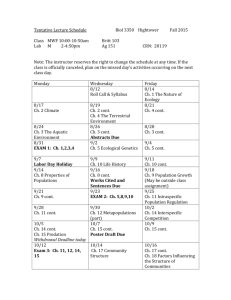Katharine L - USA National Phenology Network
advertisement
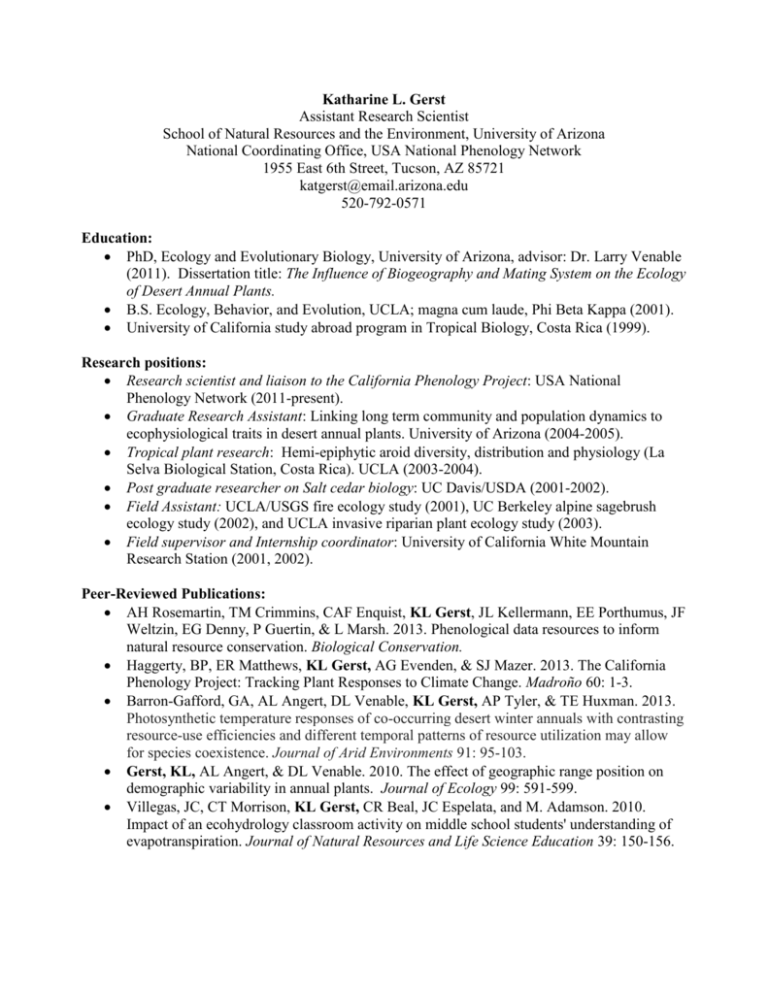
Katharine L. Gerst Assistant Research Scientist School of Natural Resources and the Environment, University of Arizona National Coordinating Office, USA National Phenology Network 1955 East 6th Street, Tucson, AZ 85721 katgerst@email.arizona.edu 520-792-0571 Education: PhD, Ecology and Evolutionary Biology, University of Arizona, advisor: Dr. Larry Venable (2011). Dissertation title: The Influence of Biogeography and Mating System on the Ecology of Desert Annual Plants. B.S. Ecology, Behavior, and Evolution, UCLA; magna cum laude, Phi Beta Kappa (2001). University of California study abroad program in Tropical Biology, Costa Rica (1999). Research positions: Research scientist and liaison to the California Phenology Project: USA National Phenology Network (2011-present). Graduate Research Assistant: Linking long term community and population dynamics to ecophysiological traits in desert annual plants. University of Arizona (2004-2005). Tropical plant research: Hemi-epiphytic aroid diversity, distribution and physiology (La Selva Biological Station, Costa Rica). UCLA (2003-2004). Post graduate researcher on Salt cedar biology: UC Davis/USDA (2001-2002). Field Assistant: UCLA/USGS fire ecology study (2001), UC Berkeley alpine sagebrush ecology study (2002), and UCLA invasive riparian plant ecology study (2003). Field supervisor and Internship coordinator: University of California White Mountain Research Station (2001, 2002). Peer-Reviewed Publications: AH Rosemartin, TM Crimmins, CAF Enquist, KL Gerst, JL Kellermann, EE Porthumus, JF Weltzin, EG Denny, P Guertin, & L Marsh. 2013. Phenological data resources to inform natural resource conservation. Biological Conservation. Haggerty, BP, ER Matthews, KL Gerst, AG Evenden, & SJ Mazer. 2013. The California Phenology Project: Tracking Plant Responses to Climate Change. Madroño 60: 1-3. Barron-Gafford, GA, AL Angert, DL Venable, KL Gerst, AP Tyler, & TE Huxman. 2013. Photosynthetic temperature responses of co-occurring desert winter annuals with contrasting resource-use efficiencies and different temporal patterns of resource utilization may allow for species coexistence. Journal of Arid Environments 91: 95-103. Gerst, KL, AL Angert, & DL Venable. 2010. The effect of geographic range position on demographic variability in annual plants. Journal of Ecology 99: 591-599. Villegas, JC, CT Morrison, KL Gerst, CR Beal, JC Espelata, and M. Adamson. 2010. Impact of an ecohydrology classroom activity on middle school students' understanding of evapotranspiration. Journal of Natural Resources and Life Science Education 39: 150-156. Huxman TE, GA Barron-Gafford, KL Gerst, AL Angert, AP Tyler, & DL Venable. 2008. Photosynthetic resource-use efficiency and demographic variability in desert annual plants. Ecology 89:1554-1563. Angert AL, TE Huxman, GA Barron-Gafford, KL Gerst, & DL Venable 2007. Linking growth strategies to long-term population dynamics in a guild of desert annuals. Journal of Ecology 95: 321-331. Publications in review or revision: Enquist, CAF, J Kellermann, KL Gerst, AJ Miller-Rushing. 2013. Phenology for natural resource management: connecting science to practice. In Revision for International Journal of Biometeorology. Denny, E, KL Gerst, AJ Miller-Rushing, GL Tierney, TM Crimmins, CAF. Enquist, P Guertin, AH Rosemartin, MD Schwartz, KA Thomas & JF Weltzin. 2013. Standardized phenology monitoring methods to track plant and animal activity for science and resource management applications. In Revision for International Journal of Biometeorology. Presentations: George Wright Society Conference, 2013: “The California Phenology Project: A Case Study of PPSR” (oral). California Desert Research Symposium, 2012: “Reproductive ecology of selfing and outcrossing desert annual plants” (oral). Ecological Society of America Meeting, 2012: “Implementing a regional phenology network: the California Phenology Project" (oral). Ecological Society of America Meeting, 2010: “The effect of pollen limitation and resource availability on reproduction in selfing and outcrossing annuals” (poster). Noon seminar, Ecology and Evolutionary Biology, University of Arizona, Fall 2010: “Interannual variability in plant and pollinator phenology” Ecological Society of America Meeting, 2009: “Timing of reproduction in outcrossing and selfing desert annual plants: the role of pollinators and herbivores” (oral). Noon seminar, Ecology and Evolutionary Biology, University of Arizona, Spring 2009: “How pollinators, herbivores, and mating system mediate reproductive success in annual plants” Ecological Society of America Meeting and Pollination conference, 2008: “Resource limitation and allocation in selfing and outcrossing desert annual plants” (poster). NSF GK-12 conference, Washington DC, 2008. “Reproductive ecology of selfing and outcrossing Camissonia” (poster). Noon seminar, Ecology and Evolutionary Biology, University of Arizona, Fall 2007: “Resource allocation in selfing and outcrossing desert annual plants” Noon seminar, Ecology and Evolutionary Biology, University of Arizona, Spring 2007: “Reproductive consequences of female biased sex ratios at the range margin in Bursera microphylla” Ecological Society of America Meeting, 2006: "Mating system evolution in Bursera microphylla (Burseraceae)" (oral). Teaching and Outreach: Graduate Associate in Education and Outreach for Biosphere 2 (2008-09). Teaching Assistant, University of Arizona: Conservation Biology (2004-2006), Natural History of the Southwest (2007), and Ecology (2009). Guest lecturer for Desert Flora lecture series at the Desert Institute, CSU San Bernardino. Develop and taught science curriculum in 3rd-5th grade classrooms in Tucson Unified School District as a BioME NSF GK-12 fellow (2007-2008). Guest lectures in: Conservation Biology (2004-07), Environmental Biology (2005-07). Service: PlantingScience.org mentor, Botanical Society of America (2007-present). Content expert for middle school science teacher training for units in Ecology and Biodiversity, Tucson Unified School District. Manuscript reviewer: International Journal of Plant Sciences, New Phytologist, Ecosphere, Journal of Ecology. Grants, Awards and Honors: Marshall Foundation Dissertation Fellowship (2009-2010). California Desert Research Fund (Community Foundation), $3300 (2008), $3800 (2009). University of Arizona College of Science Service Award Nomination (2009). Garden Club of America Desert Studies Grant $4000 (2008). McGinnies Scholarship in Arid Land Studies (University of Arizona) $1000 (2008). Travel Award, Plant Population Ecology section of ESA, $295 (2008). Biodiversity Travel Grant (University of Arizona), $2029 (2008). BioME NSF GK-12 Teaching Fellowship, $30,000 (2007-2008). Cactus and Succulent Society of America Research Grant, $1450 (2006). Graduate Student and Professional Council Travel Award, $400 (2006, 2009). Honorable Mention, NSF Graduate Research Fellowship Program (2006). Rabbi Maurice T. Galpert Memorial Scholarship, $2000 (2005). Lucretia B. Hamilton Scholarship (University of Arizona), $500 (2005). Professional Membership: Ecological Society of America (since 2005), Botanical Society of America (since 2005).

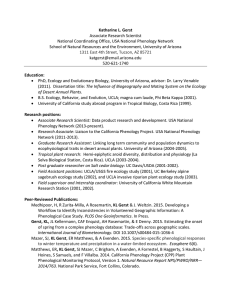

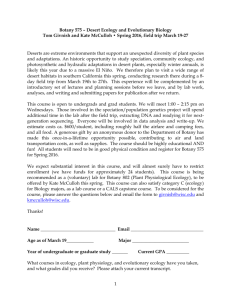


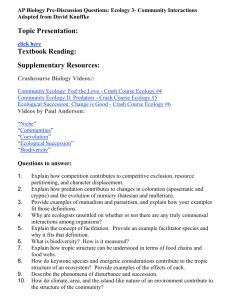

![[CLICK HERE AND TYPE TITLE]](http://s3.studylib.net/store/data/006863514_1-b5a6a5a7ab3f658a62cd69b774b6606c-300x300.png)

